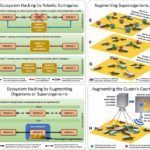Paper, A Minimally Invasive Approach Towards “Ecosystem Hacking” With Honeybees
Honey bees live in colonies of thousands of individuals, that not only need to collaborate with each other but also to interact intensively with their ecosystem. A small group of robots operating in a honey bee colony and interacting with the queen bee, a central colony element, has the potential to change the collective behavior of the entire colony and thus also improve its interaction with the surrounding ecosystem. Such a system can be used to study and understand many elements of bee behavior within hives that have not been adequately researched. We discuss here the applicability of this technology for ecosystem protection: A novel paradigm of a minimally invasive form of conservation through “Ecosystem Hacking”.
Learn about our two Decals!
 Click here to find out more about our Fall Bioinspired Design Decal and our Spring Bioinspired Design in Action Decal – ALL MAJORS are welcome.
Click here to find out more about our Fall Bioinspired Design Decal and our Spring Bioinspired Design in Action Decal – ALL MAJORS are welcome.Berkeley BioDesign Community
 Click here to learn about the BioD: Bio-Inspired Design @ Berkeley student organization or here to signup for more info.
Click here to learn about the BioD: Bio-Inspired Design @ Berkeley student organization or here to signup for more info.Search
Student Login




I imagine that the neurological circuits underlying these processes are governed by both 2d spacing maps with their brains as…
to reduce the impact of car accidents, it may be possible to study the force diverting physics of cockroaches to…
you see this type of head-bobbing stability in many avian creatures related to pigeons like chickens. the head ability to…
not like they taught horses how to run! this is an example of convergent evolution where both sea creatures and…
The brain functions in a similar way with neuronal connections. our brains are able to utilize the multiplicity of connections…